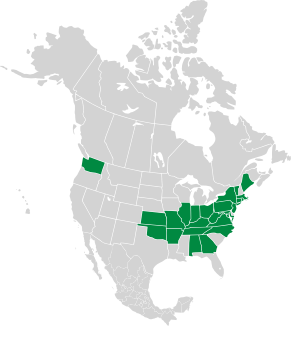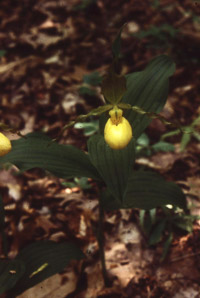|
Cypripedium parviflorum Salisb. var. pubescens (Willd.) Knight
Yellow lady’s slipper, greater yellow lady’s slipper, large yellow lady’s slipper
| Kingdom | Plantae | Plants, but not fungi, lichens, or algae |
| Subkingdom | Tracheobionta | Vascular plants—plants with a “circulatory system” for delivering water and nutrients |
| Division | Magnoliophyta | Flowering plants, also known as angiosperms |
| Class | Liliopsida | Monocots (plants with a single seed leaf); includes the lily family |
| Subclass | Liliidae | Includes lilies, orchids, and many others |
| Order | Asparagales | A diverse group that includes asparagus |
| Family | Orchidaceae | Orchid family |
| Genus | Cypripedium | Latinization (albeit an incorrect one) of ancient Greek words meaning “Venus’ shoe” |
| Species | parviflorum | |
| var. | pubescens | |
About plant names...
Yellow lady’s slippers, members of the orchid family, are native to North America, and may be native to
Eurasia as well. It is not clear whether the Eurasian varieties are separate species. Because these species are
highly variable, botanists also have a difficult
time distinguishing among several varieties of North American yellow lady’s slippers.
Plants: Plants are 8-30″ (20-76 cm) high, but much smaller in exposed or cold conditions, or in calcium-bearing soil. There
are one or two flowers on each stem.
Leaves: Leaves are 6-8″ (15-20 cm) long and 2½-3½″ (6.3-8.9 cm) wide, elliptical in shape, with roughly parallel veins.
Flowers: The slipper-like
flower is called the lip, and is yellow, often with purple veins or red dots, 1-2″ (2.9-5.4 cm) long,
larger than the other varieties of Cypripedium parviflorum.
Three sepals extend from the base of the flower, usually twisted or wavy, greenish-yellow to purple-brown,
each up to 3½″ (8.9 cm) long.
Fruits:
Here are some varieties of yellow lady's slippers. Some botanists believe Cypripedium parviflorum var. parviflorum and C. parviflorum var. pubescens are the same species.
|
|
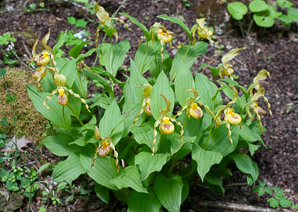
5/15/2010 · Garden in the Woods, Framingham, Massachusetts · ≈ 1½ × 1′ (52 × 34 cm) 
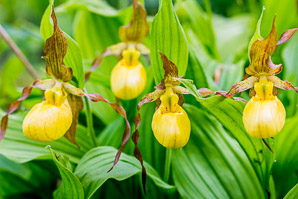
5/21/2012 · Wild Gardens, Sieur de Monts, Acadia National Park, Maine · By Susan Cole Kelly 
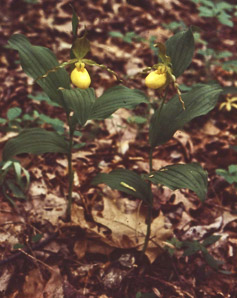
4/15/1979 · Virginia · By Tim Chandler 
|






